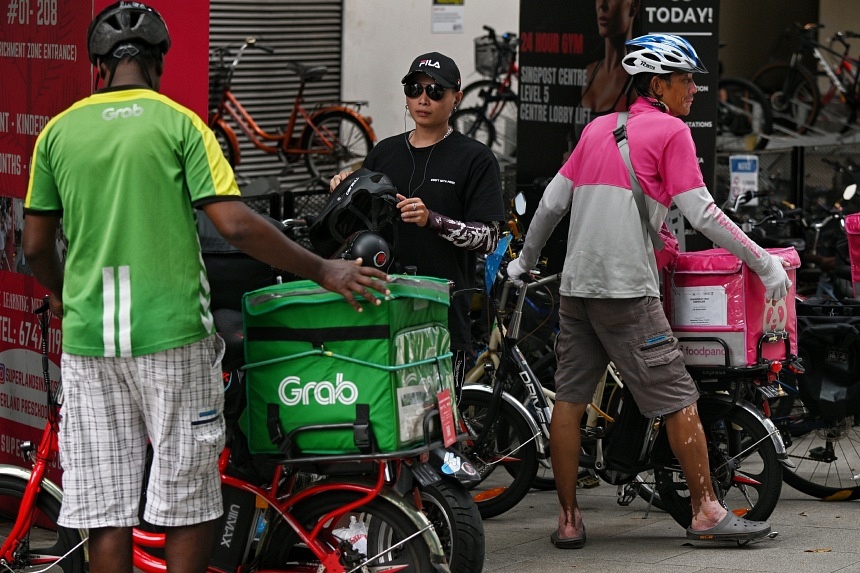SINGAPORE - Younger platform workers who will need to pay more CPF contributions, and others who opt in to do so, will have these contributions fully paid for in the first year.
This is among enhancements to the Platform Workers CPF Transition Support (PCTS) scheme announced on Aug 22. They are aimed at easing the group’s concerns about their take-home pay.
The scheme, as well as stronger protections for platform workers, will kick in from Jan 1, 2025.
Some of these moves had been slated to start from the second half of 2024, but the Ministry of Manpower (MOM) said the new single start date for all the measures is more convenient and intuitive for both platform workers and operators.
Under the enhancements to PCTS, the first tranche of support by the Government – now set for 2025 – will cover 100 per cent of the increase in CPF contributions borne by platform workers born in 1995 and after, plus older platform workers who opt in. This is up from 75 per cent.
The second tranche, for 2026, will be raised from 50 per cent to 75 per cent.
The third tranche, for 2027, will remain at 50 per cent, and the fourth and final tranche in 2028, at 25 per cent.
The tranches have been shifted to start from 2025, in line with the change in timelines to align with the start of the calendar year, rather than mid-year.
The PCTS is meant to cushion the decline in take-home pay that platform workers will face having to pay more Central Provident Fund contributions.
The support tapers off in tandem with stepped increases to Ordinary Account and Special Account contribution rates these workers bear, towards the same rate employees contribute today by 2029.
For instance, employees aged 55 and below contribute 20 per cent of their pay to CPF.
The qualifying monthly income cap for the PCTS will also increase, from $2,500 to $3,000.
MOM said the increase is in tandem with the Workfare Income Supplement scheme, which will be enhanced from January 2025 to increase the qualifying monthly income cap to $3,000.
The other key changes set to start from Jan 1, 2025, are requirements for platform operators to provide CPF contributions on a par with employers, as well as pay work injury compensation to platform workers.
Greater representation for platform workers, including allowing the formation of representative bodies that can sign collective agreements with operators, will also be enacted from the same date.
The entire suite of upcoming moves was previously announced at various points in 2023.
A Bill for these changes was tabled in Parliament on Aug 6, and they will come into force when passed.
Senior Minister of State for Manpower Koh Poh Koon said on Aug 22 that the increased offset under the PCTS will ensure those platform workers who must, and those who wish to, make CPF contributions will face a more gradual impact on their take-home pay.
Dr Koh announced the changes on the sidelines of an industry visit to platform operator foodpanda’s headquarters in Robinson Road.
He added that the Government decided to increase the offset rather than slow down the pace of increase in the workers’ contributions because it will ensure compound interest can be earned over a longer time on a larger sum.
He also said the new start date is a response to feedback from both operators and platform workers, and helps to ease the shift, especially in terms of tax calculations and other requirements that are based on the calendar year.
Dr Koh noted that under the social compact Singapore hopes to entrench, operators and consumers also have a role to play in building a stronger and more resilient platform worker workforce, especially in terms of shoring up their retirement adequacy.
On the signal the measures mean to send, he said: “The fundamental thing you want to do is to make sure that the platform economy develops sustainably, to make sure that there is a level playing field for all the operators in this space, (and) to treat all working persons equally.”
While the increased CPF contribution rates will be especially beneficial for younger platform workers to meet their housing needs, Dr Koh said the Government hopes more of those aged above 30 will consider opting in as well, with the additional support easing the impact on their cash flow.
He also said the $3,000 threshold is intended to support workers who are “more precarious”, but said the number could be adjusted with income and cost-of-living changes in time.
Ms Eveline Li, 34, is one platform worker who is still mulling over whether to opt in to the higher Ordinary Account and Special Account rates.
She has been delivering meals under foodpanda for nine months.
On the PCTS, she said: “Definitely, (the offset) at the start will help, and then, slowly, we will try to adapt.”
She said that she and several other delivery workers she chats with find the change positive, as it helps secure their future.
She hopes the increased CPF contribution rates will also make it easier to secure housing loans as lenders place an emphasis on a stable income.
Responding to the announcements on Aug 22, the Digital Platforms Industry Association (DPIA) – which represents Grab, foodpanda and Deliveroo – said in a statement that the confirmation of a Jan 1, 2025, start date offers a clear timeline for platforms to work towards to be prepared for the upcoming changes.
“It is also crucial to recognise that the gig regulations encompass a wide range of protections, which entail significant costs for implementation and ongoing support,” it said.
“For the legislation to succeed, it will require the collective commitment of the entire community – government, platform operators and consumers. DPIA echoes MOM’s sentiments that consumers should play their part to support this.”


